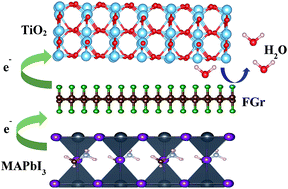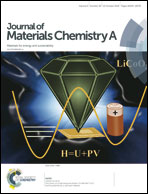A highly hydrophobic fluorographene-based system as an interlayer for electron transport in organic–inorganic perovskite solar cells†
Abstract
Degradation of perovskite halide materials under humid conditions is one of the major hurdles in the commercialization of organic–inorganic perovskite solar cells. Herein, we studied the interface between highly hydrophobic fluorographene (FGr) and cubic methylammonium lead iodide (MAPbI3, MA: CH3–NH3) by employing density functional theory (DFT)-based simulations. We demonstrate that the adsorption of FGr on MAPbI3 results in the formation of a stable interface with appreciable binding energy (∼0.4 eV per Pb atom). Thorough assessment of energy-level alignment indicates that the FGr/MAPbI3 interface has desirable properties with regard to the electron transfer (hole blockage) process. These results underscore the potential of using FGr as an interlayer for electron transport between a perovskite layer and an electron transfer medium (such as TiO2) as well as a moisture blocker for achieving high perovskite stability by perfect waterproofing. The future research study towards the integration of hydrophobic FGr or electronically optimized partially fluorinated graphene-based systems within perovskite halide photovoltaic devices may pave the way for stable and efficient solar cell technologies.



 Please wait while we load your content...
Please wait while we load your content...